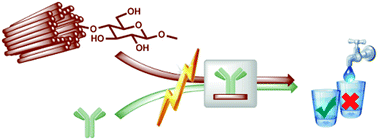Photolinker-free photoimmobilization of antibodies onto cellulose for the preparation of immunoassay membranes†
Abstract
Paper-based detection devices such as lateral flow immunoassays (LFIAs) are inexpensive, rapid, user-friendly and therefore highly promising for providing resource-limited settings with point-of-care diagnostics. Recently, this biosensing field has trended towards three-dimensional microfluidic devices and multiplexed assay platforms. However, many multiplexed paper-based biosensors implement methods incompatible with the conventional LFIA carrier material: nitrocellulose. It thus tends to be replaced by cellulose. This major material change implies to undertake a covalent immobilization of biomolecules onto cellulose which preserves their biological activity. In this perspective, the immobilization process elaborated in this study is entirely biocompatible. While antibody immobilization onto cellulose usually requires chemical modifications of either the biomolecule and/or the membrane, the light-based procedure presented here was performed without any chemical photolinker. Native biomolecules have been successfully immobilized onto paper sheets which therefore enable to perform LFIAs. More generally, the process expounded herein is fast, simple, cost-saving, environmentally-friendly and would be helpful to immobilize chemical-sensitive biomolecules onto cellulose sheets.


 Please wait while we load your content...
Please wait while we load your content...